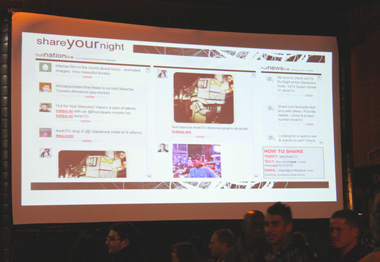Nuit Blanche is going to go on, strong and healthy: Interview with Julian Sleath (J.L.) Programming Manager of Scotiabank Nuit Blanche
With Scotiabank Nuit Blanche just around the corner, Artoronto.ca contributor Seowon Bang (S.B.) and the programming manager of special events at the City, Julian Sleath, engage in a conversation about Nuit Blanche and the past, present, and future of the city’s most prolific one-night art crawl.
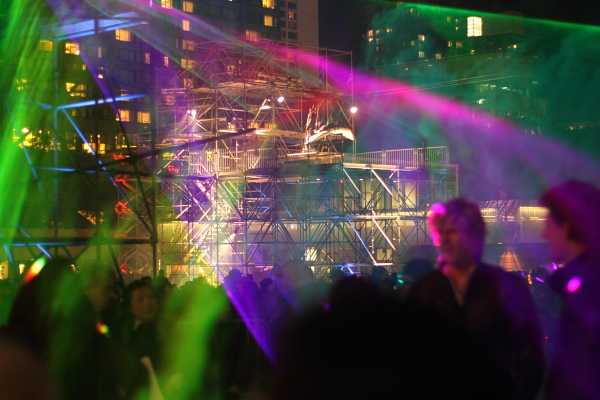 Usman Haque and Natalie Jeremijenko, Flightpath Toronto, 2011. Photo: Mauricio Contreras-Paredes
Usman Haque and Natalie Jeremijenko, Flightpath Toronto, 2011. Photo: Mauricio Contreras-Paredes
THE PAST
S. B: In the past, there has always been the debate of the spectacular and the populist vs. the critical and the “high art” when it came to Nuit Blanche – I’m sure this is old news to you. Nuit Blanche is meant to be a spectacle, not a mum art in a white box. Do you agree?
J. S: The original mandate for Nuit Blanche in Paris was to transform the city, to put the unfamiliar in a familiar setting. We strategically work with curators and artists in places that are usually not expected to show art in—we try to look at public spaces differently. It’s interesting you mention the “white box.” Many institutions are involved to provide a full range of experiences, to provide many ways of enjoying contemporary visual art. It’s about the journey into the “white boxes.” Instead of dragging people to see the art or vice versa, we’re bringing the two together. There’s something incredible about the energy out of something that’s only there for 12 hours, like iconic pop concerts. Everyone can participate; Nuit Blanche breaks down the barriers in terms of whether you can afford to enjoy art, or how much you know about art.
S.B: How do you respond to criticisms that Nuit Blanche has turned into an all-night booze party? There must also be security concerns, including crowd control, navigation, etc. Have there been incidents? How would you reassure visitors?
JS: There are many things involved in organizing Nuit Blanche—infrastructure, road closures, etc. managed by an experienced team that brings you Canada Day, Doors Open, concerts and many more. In the first year of Nuit Blanche, people didn’t know what to expect. In this city, there is a passionate demand for large pedestrian experience. People want permission to stay out all night! It’s different from European cities. Things are shut down at 2 a.m here.
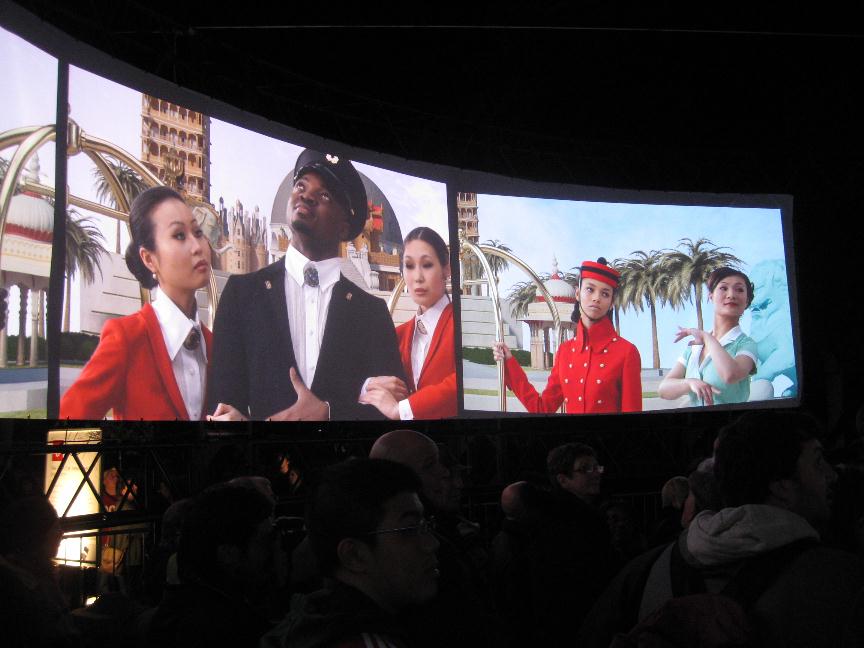 AES + F, The Feast of Trimalchio, 2011. Photo: Phil Anderson
AES + F, The Feast of Trimalchio, 2011. Photo: Phil Anderson
S.B: In Europe, on the other hand, the nightlife never dies. A bit of night stroll, a sip of wine…
J.S: Exactly. Inevitably, people in Toronto end up focusing not always 100% on contemporary art during Nuit Blanche. However, I hope some of them are pleasantly surprised. Who knows, they might stumble into a gallery one day and say, ‘Hey, I saw this artist’s work in Nuit Blanche the other night!’
SB: Nuit Blanche is like an extended opening night crawl, in a way. People rarely come to openings to see art.
J.S: Or like any other big cultural events, sporting events, or concerts, for which there is always a concern for crowd control and public safety. But these are not as heavily scrutinized as Nuit Blanche. Nuit Blanche is a big event that draws big crowds, and our team does everything to ensure it runs smoothly.
Nuit Blanche, of course, does not condone reckless drinking. Our efforts are always on the visual art. Some people are now starting their night at 3 a.m, after the ruckus is over and things quiet down. There’s definitely an arc in the audience concentration. So this is an alternative if you want to experience the art but don’t want the big crowds and noises. Try to steer clear of the entertainment district, as well. There are also family-friendly Nuit neighbourhoods, like Artscape Wychwood Barns, Distillery District, Parkdale Village BIA and Queen West BIA.
SB: Artworks are sprawled across the city, and Toronto has distinct pockets of neighbourhoods with different vibes. Miriam Arbus of artoronto.ca had a suggestion of maybe providing a better way of navigating people through the city. How would you respond to this?
J.S: We have various tools like event guides, maps, and even apps to help people navigate through Nuit Blanche. On the Plan Ahead section of our website, we give you tips like how to get around the city, where to eat, and many more. They’re all available for you—people just have to invest more time when they are planning to go to Nuit Blanche. The tools are there.
THE PRESENT
SB: What’s new this year? Is there a special project or a notable new collaboration you’d like to highlight?
J.S: Our focus is always on visual art, free, all night. To achieve this, we invite curators to pitch proposals and themes, and actively commission programs. For “Museum for the End of the World,” curated by Janine Marchessault and Michael Prokopow, the City Hall is devoted to 14 projects. City Hall becomes a museum for one night—from the parking lot up to loading dock to the Council Chamber and the Nathan Phillips Square. It’s such an unexpected place for art. A symposium with York University will be held in the Council Chamber as well.
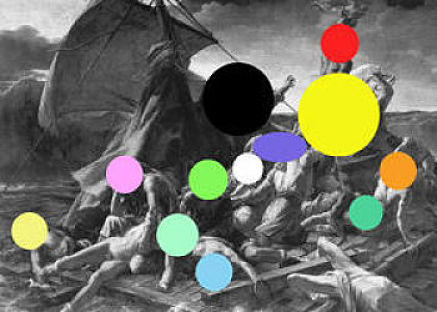 Museum of the Rapture, 2012, Douglas Couplan, Vancouver, Signage, Tableaux vivants, Zone B City Hall Project
Museum of the Rapture, 2012, Douglas Couplan, Vancouver, Signage, Tableaux vivants, Zone B City Hall Project
We are excited to be working with The Power Plant for the first time this year for a special 24-hour viewing of Christian Marclay’s The Clock. (The Power Plant, 231 Queens Quay W. For more information about The Clock, visit thepowerplant.org.)
Janet Cardiff’s sound sculpture is another amazing installation. (Janet Cardiff’s Forty-Part Motet will be on view at Trinity-St. Paul’s Centre for Faith, Justice and the Arts, 427 Bloor St. W.)
Regent Park Arts & Cultural Centre is also our new partner and they will be hosting Nuit Blanche programs as well as celebrating their new home. (Regent Park Arts Cultural Centre, 585 Dundas St. E.)
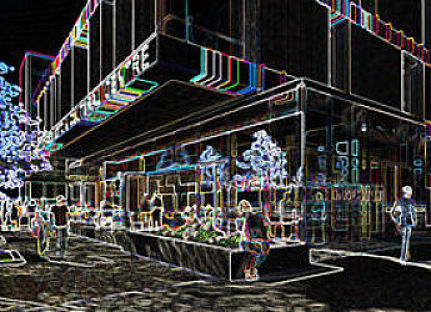 Regent Park Arts & Cultural Centre, Our Lights Are On! 2012, Zone C Independent Project
Regent Park Arts & Cultural Centre, Our Lights Are On! 2012, Zone C Independent Project
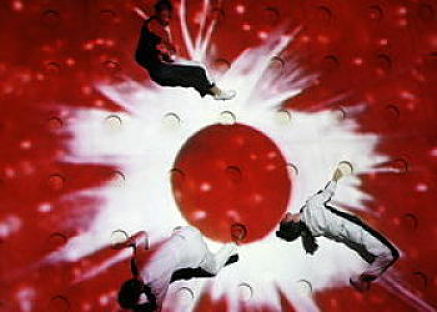 Planes, Trisha Brown Dance Company – New York, 2012, Zone C Exhibition Project
Planes, Trisha Brown Dance Company – New York, 2012, Zone C Exhibition Project
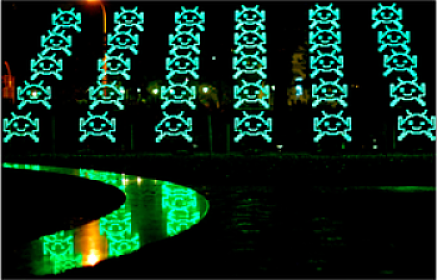 Green Invaders, 2012, Yves Caizergues – Lyon, Zone A Exhibition Project
Green Invaders, 2012, Yves Caizergues – Lyon, Zone A Exhibition Project
S.B: How has the development of social media impacted Nuit Blanche?
J.S: We have something called “Share your night.” Across the city in key locations, screens of social media stream displays messages sent to us by you, the audience.
Some pieces change locations. Germaine Koh pushed a rock down Young St, GPS-linked. The locations are updated via social media so that people can follow her progress, of they wanted to.
Social media is great for marketing and PR, but artists are using it as a medium these days.
THE FUTURE
S.B: What does the future have in store for Nuit Blanche—new developments, ideas, collaborations?
JS: We are discussing the possibility of keeping the installation for more than one night. We have such great projects and installations, so it’s a shame to see them removed so quickly. But we also do not want to dilute the one-night-only experience. We’re still thinking—it’s an idea.
Nuit Blanche is not a business, like Canadian Music Week. It’s about the iteration of contemporary visual art that’s available for all cities, towns, and collectives. There are similar all-night art events popping up around Canada, around the globe. We do not control them, but we’d love to collaborate. There is a tapestry of arts and culture, and we rely on one another.
S.B: Martin Knelman was apprehensive about Nuit Blanche’s fate last year, and mentioned putting Nuit Blanche “up for adoption.” Is that still on the table? The departure of Rita Davies, who was instrumental in launching Nuit Blanche, must bring some shifts in terms of cultural initiatives, especially when the city’s arts funding is facing cuts in all direction.
 Beam of Underground Sun , 2012, Arezoo Talabzadeh, Kaveh Ashourinia, Toronto. Zone A Exhibition Project
Beam of Underground Sun , 2012, Arezoo Talabzadeh, Kaveh Ashourinia, Toronto. Zone A Exhibition Project
J.S: I haven’t heard anyone talking about Nuit Blanche being “adopted” by the private sector, as far as I know. Arts planning is well ahead in 2014—we intend to continue. Nuit Blanche is a large-scale public event, so it’s inevitable that Nuit Blanche is discussed every time someone talks about funding cuts. Comes with being successful, I guess.
S.B: In March, the local art scene was shaken by Ontario government’s decision to slash the funding for Luminato by more than 40% and reduce support for other arts organizations. Are you confident about Nuit Blanche’s financial situation?
J.S: 73% of our funding is met by sponsors and granting bodies. Nuit Blanche draws crowds, many of them tourists—it’s promoting Toronto as a great place for visual art to both locals and tourists. Hotels are willing to partner with us, and we’ve got travel partnership with Porter Airline, GO Transit, and VIA Rail. And of course, the City relies on the importance of tourism.
The life sign is good. Nuit Blanche is going to go on, strong and healthy.
(Featured image: Metropolis, Nuit Blanche, 2011. Photo: AdrianOosterman)

